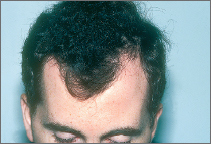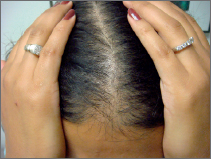Androgenic alopecia (AGA), also known as common baldness and male- or female-pattern alopecia, is an extremely common type of hair loss that becomes more noticeable as people age.
Male-pattern alopecia
AGA usually produces two typical patterns of hair loss:
In men, the process usually begins in an M-shaped pattern on the front and top of the head (this is often referred to as male-pattern baldness). It usually begins in late adolescence.
In women, a thinning of the crown toward the front of the scalp occurs in a “Christmas tree” pattern (female-pattern baldness). The loss of hair is less obvious and tends to begin later in life than it does in men.
Hair loss may progress in both sexes but is often more extensive in men. Thus, in the end stages of AGA, many men have only a fringe of remaining hair, whereas women tend to maintain their hairline and do not become totally bald.
Female-pattern alopecia
AGA is genetically determined. It can be inherited from either the mother's or father's side of the family.
It's caused by the action of an androgenic (male) hormone on hair follicles, which shortens the growth phase of the hair cycle, thus producing thinner, shorter hairs in a process known as miniaturization.
The diagnosis of AGA is generally based on the pattern of baldness coupled with an absence of clues pointing to a specific disease or drug that may cause hair loss.
Your health care provider may wish to obtain blood tests if another reason for hair loss is suspected.
Minoxidil 5% solution and foam (Rogaine for Men), applied twice daily, may reduce shedding and may possibly contribute to some regrowth.
Finasteride (Propecia) is an antiandrogen. It is for the treatment of male pattern hair loss in MEN ONLY and should NOT be used by women or children.
Discontinuation of treatment produces a rapid reversion to the pretreatment balding pattern.
Minoxidil 2% solution (Rogaine for Women), applied twice daily, may reduce shedding and may possibly contribute to some regrowth. Regrowth may not be noted for at least 4 months. Continuing topical treatment with the drug is necessary indefinitely, because discontinuation of treatment produces a rapid reversion to the pretreatment balding pattern.
Women with excess androgen may benefit from antiandrogen medications, including oral contraceptives that lessen androgen production.

